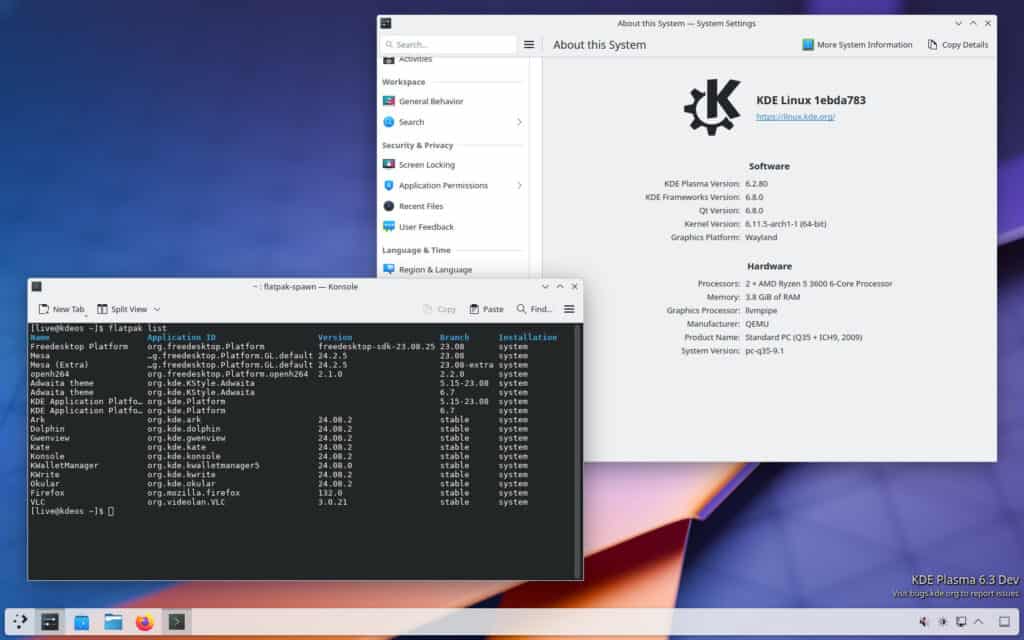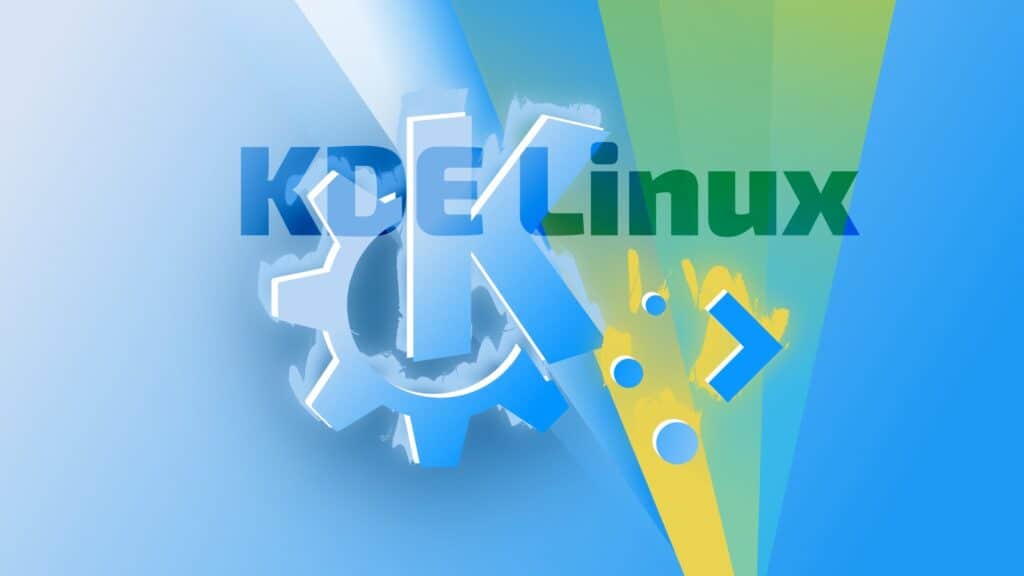Surprises never end. The KDE project is about to take a bold step by introducing its own Linux distribution. Here’s what it’s all about.
Introduced at Akademy 2024, KDE Linux (codenamed “Project Banana”) is a brand-new, still-in-development initiative by the KDE devs to bring a seamless, user-friendly experience that merges KDE software’s reliability and rich interface with cutting-edge Linux technologies.
Immediately, we want to clarify that this isn’t a rebranded version of the well-known KDE Neon developed by the KDE community. KDE Linux is an entirely new project with a completely different technical approach under the hood and ambitious goals for both developers and end users.
KDE Linux: A Vision for the Best KDE Experience
The distro is designed to be a bulletproof, highly user-friendly operating system that showcases the best of KDE technology—a system that KDE can confidently recommend to casual users and hardware manufacturers.
With an eye on simplicity, the OS will use Btrfs for its file system and introduce an image-based (immutable) approach, allowing users to easily switch between different OS versions, ensuring a secure, flexible experience without the stress of traditional system management.
KDE Linux will feature rolling OS updates based on snapshot releases and employs systemd-boot with custom theming. All mutable data, such as user home directories and cache locations, is encrypted for enhanced security.
Moreover, the architecture also includes an image-based A/B update mechanism with rollback capabilities and a recovery partition for added resilience. Users can benefit from an automatic backup system using Btrfs snapshots, which includes a user-friendly GUI similar to Apple’s Time Machine.
Using Arch as a base, KDE Linux aims to attract a broad audience, including KDE developers, enthusiasts, and hardware vendors. It will include applications from Flatpak (and possibly Snap), helping to keep the core system and applications separate for greater stability.

Among KDE Linux’s top priorities are a high-quality user experience and a system that “doesn’t break”—or, at the very least, is easy to recover if things do go awry. To keep development accessible, KDE Linux requires no packaging knowledge, simplifying the process for anyone wanting to contribute to its growth.
In keeping with modern expectations, KDE Linux will feature technologies like Wayland by default and a read-only base system, similar to other immutable Plasma-focused Linux distros like openSUSE Kalpa and Fedora Kinoite. This approach ensures that the core operating system remains tamper-proof and reliable while user-specific data remains flexible.
There are several editions planned for KDE Linux, each built to suit a different group of users:
- Testing Edition: Updated daily and aimed at quality assurance testers and KDE developers.
- Enthusiast Edition: Targets KDE enthusiasts and power users with beta and stable releases.
- Stable Edition: Built for everyday users, with a delayed release schedule that prioritizes stability.
These will allow users to choose between the latest features or a more conservative, stable environment. Moreover, should their needs change over time, switching between editions will be simple and risk-free.
What Makes KDE Linux Unique?
Now, on to the other main question—why do we need another heavily KDE-focused distribution when we already have KDE Neon and KaOS? The main difference lies in the fact that, unlike some other Linux distributions, KDE Linux will be distributed by KDE itself, which brings many advantages.
First, it ensures a clear chain of responsibility that isn’t reliant on third parties, enabling KDE to build direct relationships with hardware partners and recommend KDE Linux without favoritism.
Furthermore, KDE Linux will use systemd tooling, such as systemd-sysupdate, for seamless updates, making it more efficient compared to other distros relying on different update methods.
For those unfamiliar, systemd-sysupdate is a system service that allows unprivileged clients to update the system, which brings the benefits of an image-based design, including immutability, automatic updates, adaptability, factory resets, and uniformity.
On top of that, the distro will also distinguish itself by its forward-thinking approach to software distribution.
Instead of relying on legacy packaging systems, KDE Linux will focus on modern deployment systems, such as Flatpak and systemd-sysext, a set of useful functionalities for managing system extension images, thus keeping the applications and the immutable base system separate for easier maintenance and development.
This means developers don’t need traditional packaging skills—they simply target Flatpak and other containerized formats.
Lastly, another unique aspect is KDE Linux’s approach to long-term maintenance. In case the distribution reaches its end of life, the KDE team plans to push a final update that transforms KDE Linux into a different supported distribution, ensuring users always have a path forward.
Refer to the announcement, or look here for a more detailed overview of the new KDE Linux initiative.
Personal Reflections
With that in mind, here’s my take on the subject. I believe KDE Linux will primarily appeal to a smaller, specific group of users—mainly enthusiasts eager to explore the latest KDE advancements and developers—rather than the average Linux user. The main reason for this is the buzzword in recent years, “immutability.”
Don’t get me wrong; I genuinely appreciate immutable Linux systems and use them daily, especially in contexts where they shine, like containerized workloads. However, immutability on a desktop is still a tough sell for the everyday Linux user who has relied on traditional package managers for decades.
While immutability does simplify things for developers by sidestepping the “dependency hell” of package management and provides a secure and very reliable OS foundation, it often complicates things for non-developers outside of the DevOps community. But again, this is just my personal view on the matter.
Anyway. We’re excited to see how things progress and look forward to the first stable release. Meanwhile, the distribution is currently available as an 11 GB RAW file for those eager to try it out. You can write it to a USB stick or import it into virtualization software like KVM’s virt-manager.

i want to try this. all i use for software is snap and flatpak and i prefer having both since there are some things i can not find on flatpak and vise versa. this distro sounds perfect.
why choose Arch ?
if openSuSE has already tooling built to work with btrfs,
and its rolling release distro (tumbleweed) updates QT based projects faster than arch linux,for example 'tumbleweed' updated to lxqt 2.1 soon after release, but arch still didn't do it,
and tumbleweed is generally more stable and has support for 'openSuSE kalpa'which has similar goals like project banana
Kde forever
I think the author, from his perspective as an experienced and knowledgeable Linux user surrounded by like minded people, might forget that experienced power users are a tiny minority of the PC user market. There is a huge market of potential new Linux users coming around the corner. By that I mean people who are being driven away from Windows by Microsoft's Corporate arrogance with Win11 and their upcoming end of support for Win10 but are hesitant to move to Linux because of the stories they keep hearing of having to do what is, from their perspective, "voodoo magic" to fix an install that just broke itself in an update. Most of them are not interested in learning how to build, maintain and repair a kernel, or what dependencies are or what the differences are between package managers. They don't know or care what "immutable" means. All they want is something that they know will work every time they turn their computer on even after an update and that is easy to use with intuitive graphical interfaces without having to learn console commands for everything. KDE Linux might turn out to be exactly what they want.
I know because I am one of them who did the switch this year. Mint was my "entry drug" but I quickly found out that I wanted Plasma 6 for the better customization and support for multiple displays. Tumbleweed is what I'm currently running but I'm terrified that one day an update will break something that I won't be able to fix and that the BTRFS rollback won't be of any help. If KDE Linux turns out to be a solid choice I'm jumping on it.
I use openSUSE Tumbleweed. That uses the BTRFS file system already and used snapshots to update the system (it is recommended to do this from the command line in another terminal as root to avoid issues). Snapshots are great for recovering a corrupted system and I have used them to do that in the past.
I also prefer to use flatpaks and AppImages for user software because of the issues with rolling releases frequently breaking software installed from third parties that are not directly supported by the distro – which has happened several times to me using Tumbleweed.
I wouldn't mind this new distro except for one reason: I do NOT want an encrypted file system, nor do I use encrypted backups. Why? Because I do NOT believe in the reliability of encrypted file systems. Almost every day in my RSS feeds I have seen people post items to the effect of: "I tried to boot into my encrypted file system today – and couldn't. How can I recover my data?"
Anyone who trusts the state of software development to encrypt their entire data – including their backups – is delusional and it will eventually bite you in the butt. It also does not provide "foolproof security" because 1) encryption software has been beaten in the past due to flaws, and 2) the system – especially the user – can be otherwise compromised to bypass the encryption.
I also won't use this new distro because it uses image backups. Image backups are fine for recovering the system directories. But I want the ability to restore individual files – system or user data – that have been corrupted or that I accidentally deleted from backup manually. Backups must not be encrypted or stored as archives that can not be restored individually. I don't any form of archived file because they can be corrupted and if you corrupt one bit the whole archive is compromised. That is why I use FreeFileSync to do my backups.
I have used encryption for my systems and backups forever with zero issues. I prefer everything to be encrypted and always will but i know how to restore both my system and files if needed.